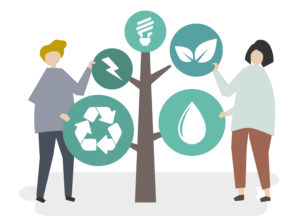
See How National Tile is Using ENSO to Identify and Communicate Sustainability Opportunities
April 22, 2024
Reducing Waste and How the Circular Economy Can Help
May 3, 2024The Irish Government just released their new Green Public Procurement Strategy and Action Plan 2024-2027. In this plan, green public procurement (GPP) is defined as “a process whereby public bodies seek to procure goods, services and works with a reduced environmental impact throughout their life cycle when compared to goods, services and works with the same primary function that would otherwise be procured.”
This plan covers the entirety of the public sector, whose purchasing accounts for 10% to 12% of Ireland’s total GDP. The public sector spends €18.5 billion annually on goods, services, and works. This means that they have the potential to drive changes towards a more circular, sustainable economy through GPP practices and the ways in which they spend their money. With this new GPP strategy and action plan, the government is putting in place the tools for the public sector to make a positive environmental impact.

Overview of the Green Public Procurement Strategy and Action Plan 2024-2027
The overall goal of the new GPP plan is to drive the implementation of green and circular procurement practices across the public sector. This is done through specific focus areas:
- Acceleration of GPP implementation using national guidance and criteria
- Increasing awareness of the use and value of GPP through communication and training
- Demonstration of how GPP is implemented through monitoring and reporting
- Providing direction in undertaking market engagement on GPP and research and innovation
- Participating in EU and international initiatives on GPP
As of the publication of this strategy, all Central Purchasing Arrangements that are published will include specific GPP criteria where possible. This will include minimum environmental or sustainability criteria, the specifics of which we will discuss more in depth later in this blog.
The reach of GPP practices will expand by the end of 2025. At this point, all public bodies with an annual public procurement spend above €200 million will have to assess their procurement processes in order to align with ISO 20400:2017. This ISO standard provides guidance to any organisation, regardless of sector or size, on how to integrate sustainability into their procurement processes.
How Will Contracts and Tenders Change?
When public sector organisations implement GPP into their procurement processes, they will still observe principles such as equal treatment, non-discrimination, transparency, and mutual recognition. GPP does not replace any of these considerations, it simply adds a new dimension and expands considerations within the contract and tendering process. When GPP criteria is added, it must be linked directly to the subject matter of the contract. This means that you will not be asked for information that does not connect in some way to the contract or your ability to deliver a product or service.
At a base level, all businesses need to be in compliance with environmental, labour, and social regulations. Many tenders already require, or will soon require, applicants to fill out the European Single Procurement Document (ESPD), which allows you to self-declare compliance. This declaration should be accepted, but keep in mind that future evidence may be required down the line should any issues arise.
Getting into the specifics of tenders, GPP can be applied across the technical specifications, selection criteria, and award criteria. We will now discuss how this can work in each of these areas.
Technical Specification
GPP can be integrated into technical specifications as a method of promoting the provision of environmentally compliant solutions that meet the needs and requirements of the tender. When implementing this, technical specifications must remain non-discriminatory, afford equal access, and not create unjustified barriers to competition. Basically, the addition of environmental considerations within technical specifications should not diminish the ability of any company to compete for the tender. The addition will simply help to identify the solution that has the best environmental impacts and considerations.
Within the technical specifications certificates or other proof points may be relied upon to help support the provision of solutions that are aligned with GPP. These pieces of proof need to be objectively verifiable and must connect to the subject matter of the tender. For example, third party labels may be used and referred to but they have to be relevant, verifiable, and non-discriminatory.
Selection Criteria
When GPP considerations are embedded in the selection criteria for a contract or tender, they should, in most cases, be assessed on a pass/fail basis. Some examples of possible selection criteria include:
- Examples and references to previous delivery of public or comparable private contracts in which environmental and sustainability considerations were used
- Details of environmental expertise, experience, and qualification of any resources named to deliver the contract
- Samples of sustainable products or services
- ISO standards, energy, and/or product standards that are minimum requirements for the tender
Award Criteria
GPP principles that were included in the technical specification or selection criteria of a tender will then be considered in the overall award criteria. Typically at least 5% of the marks will be awarded to GPP criteria. This percentage can increase up to 10% or higher for projects that more directly relate to sustainability or specific environmental activities. For example, if a tender is for a project that has a high potential of reducing greenhouse gas emissions and increasing energy efficiency significantly, the percentage of marks awarded for GPP criteria will rise accordingly.
Specific GPP Criteria versus Minimum Environmental Sustainability Requirements
Ideally, contracts and tenders will be able to add specific GPP criteria from national guidance that relates directly to their project. Public organisations can find these specific criteria using the GPP Criteria Search tool. This tool is very useful to find specifications that can be added to tenders to ensure that GPP principles are being utilised. Criteria can be found using keywords or by browsing one of the following sectors:
- Energy-related products
- Food and catering services
- Heating equipment
- ICT products and services
- Indoor cleaning services
- Indoor and outdoor lighting
- Office building design, construction and management
- Paper products and printing services
- Textile products and services
- Road transport vehicles and services.
There are other sectors, including furniture, that are currently under development and will soon have specific national GPP guidance accessible on the tool.
If there are no relevant GPP criteria from the national guidance that connect to the subject matter of the tender, organisations are encouraged to use broader international standards or guidance. For example, organisations may look to the EU GPP guidance for possible criteria to include.
In the case that there are no national or international guidelines with criteria relevant to the tender, organisations should include minimum environmental sustainability requirements. Within the Green Public Procurement Strategy and Action Plan 2024-2027, examples of how to embed these requirements are given. These examples include:
- Evidence of two recent, comparable contracts that were delivered with supporting sustainability measures
- Detailed description of the life cycle environmental impacts of the goods or services, including greenhouse gas reductions compared to alternatives
- Estimated carbon footprint from goods and any proposed mitigation measures
- Specific, practical steps that will be taken to deliver the contract in an environmentally sustainable manner, including any sustainability awareness training for any personnel involved
- Proposal for monitoring, measurement, and reporting of environmental and circular economy impacts during contract delivery
When a tender uses any GPP criteria, whether they are specific or are minimum environmental sustainability requirements, it must specify a method for verification of any claims. Let’s discuss the specific ways in which tenders might accomplish this verification.
Verification of Environmental Claims
There are multiple ways in which environmental claims on tenders can be verified. The Green Public Procurement Strategy and Action Plan 2024-2027 provides the following examples to be used to test compliance, which should be done at the tender evaluation stage:
- EU Ecolabel
- Third party certificates
- Environmental product declarations
- Self-declaration and test reports
The method of verification will be made clear on the tender and will be chosen in line with tender requirements and specifications. When you are applying for a tender, you will know what verification information you will need so you can prepare and ensure that you can back up any claims you are making.
Sectoral Standards
Within the Green Public Procurement Strategy and Action Plan 2024-2027, there are specific targets regarding certain sectors in which many purchases are made. These targets help to guide the overall procurement practices outlined in the plan as well as the specific GPP criteria that can be added to tenders. The specific sectors included are:
- The build environment
- Food procurement and action to tackle food waste
- ICT Procurement
- Textiles
- Paper products and printing services
- Energy related products, heating equipment, indoor and outdoor lighting
- Indoor cleaning services
- Road transport vehicles and services
- Social enterprises and community based organisations
The targets relating to each of these sectors can be viewed in the full plan published by the Irish government. All of the targets are listed together in Appendix II of the text. If you are operating in any of the sectors listed above, take a look at the targets. They can help guide your sustainability goals, allowing you to align with future tender criteria.

What Does This Mean For You and Your Business?
If you are applying for any tenders with public organisations, you will need to have environmental sustainability information. This may include examples of previous projects, emissions mitigation measures, monitoring practices, or other information about the environmental impact of your goods and services. Because you will need to provide more information, and proof of your claims, it will be useful to have a sustainability strategy and to keep track of your actions, with supporting documentation.
Within the guidance from the new GPP action plan, businesses are encouraged to include performance terms and conditions in contracts to ensure that environmental commitments are respected and achieved during project delivery. This means that you will have to have a plan to monitor and prove that you are delivering on your GPP promises. Having an understanding of the overall sustainability of your business and your products or services will help you achieve this. If you already have your sustainability targets and monitoring procedures in place for your overall operations, it will be much easier to comply with these contract requirements.
The inclusion of environmental sustainability considerations in public tenders is a great opportunity. As a business, you can leverage your sustainability practices to set yourself apart in the tendering process and to win new contracts and projects. Whether you have just started your sustainability journey or are well on your way, you will be able to provide strong, supported answers to any GPP criteria that relate to your business and its products and services.
The Future of GPP
Within the Green Public Procurement Strategy and Action Plan 2024-2027, many future actions are outlined. This means that there is a lot more information to come regarding GPP, particularly in terms of specific targets and requirements. We will continue to monitor any new information and will be sure to update you all as the landscape evolves!
One thing to consider is that GPP specifically refers to environmental sustainability. Within the Green Public Procurement Strategy and Action Plan 2024-2027, there is a mention of the intention to move from specifically GPP to Sustainable Public Procurement. This strategy would combine GPP and Socially Responsible Public Procurement practices to provide more holistic sustainability guidance for purchasing. This guidance still needs to be worked out and written. However, the mention of this future direction is very exciting and will be another great opportunity for businesses that are actively engaging in sustainability.


